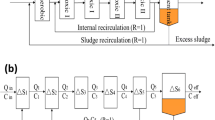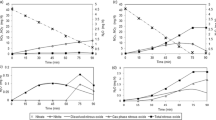Abstract
Nitrous oxide (N2O), a strong greenhouse gas, can be produced by ammonium-oxidizing bacteria (AOB) as a by-product of ammonium oxidation and can potentially be formed in all types of nitrification processes. However, partial nitritation has been reported to cause significantly higher N2O emissions than complete nitrification. In the study presented here, the mechanisms and factors that drive N2O formation by AOB were investigated with respect to different operational strategies to achieve nitrite accumulation base on combined evaluation of oxygen uptake rate (OUR) and N2O formation rate. On the one hand, N2O formation during partial nitritation and nitrification in a continuously stirred tank reactor (CSTR) with continuous aerobic conditions was observed. On the other hand, the effect of intermittent aeration on N2O formation during nitrification was investigated. The presence of nitrite, the extend of sludge-specific ammonium loading, low oxygen concentration, and transition from aerobic to anoxic conditions significantly increased N2O formation in this reactor independently from each other, indicating that different formation pathways, supposedly via nitrite or hydroxylamine, were active.





Similar content being viewed by others
References
Ahn JH, Kwan T, Chandran K (2011) Comparison of partial and full nitrification processes applied for treating high-strength nitrogen wastewaters: microbial ecology through nitrous oxide production. Environ Sci Technol 45(7):2734–2740
Bock E, Schmidt I, Stüven R, Zart D (1995) Nitrogen loss caused by denitrifying Nitrosomonas cells using ammonium or hydrogen as electron donors and nitrite as electron acceptor. Arch Microbiol 163:16–20
Chandran K, Stein LY, Klotz MG, Van Loosdrecht MCM (2011) Nitrous oxide production by lithotrophic ammonia-oxidizing bacteria and implications for engineered nitrogen-removal systems. Biochem Soc Trans 39(6):1832–1837
Chen Y, Wang D, Zheng X, Li X, Feng L, Chen H (2014) Biological nutrient removal with low nitrous oxide generation by cancelling the anaerobic phase and extending the idle phase in a sequencing batch reactor. Chemosphere 109:56–63
Colliver BB, Stephenson T (2000) Production of nitrogen oxide and dinitrogen oxide by autotrophic nitrifiers. Biotechnol Adv 18(3):219–232
Desloover J, Clippeleir HED, Boeckx P, Laing GD, Colsen J, Verstraete W, Vlaeminck SE (2011) Floc-based sequential partial nitritation and anammox at full scale with contrasting N2O emissions. Water Res 45(9):2811–2821
Fukumoto Y, Inubushi K (2009) Effect of nitrite accumulation on nitrous oxide emission and total nitrogen loss during swine manure composting. Soil Sci Plant Nutr 55(3):428–434
Gabarró J, González-Cárcamo P, Ruscalleda M, Ganigué R, Gich F, Balaguer MD, Colprim J (2014) Anoxic phases are the main N2O contributor in partial nitritation reactors treating high nitrogen loads with alternate aeration. Bioresour Technol 163:92–99
Kampschreur MJ, Picioreanu C, Tan NCG, Kleerebezem R, Jetten MSM, van Loosdrecht MCM (2007) Unraveling the source of nitric oxide emission during nitrification. Water Environ Res 79(13):2499–2509
Kampschreur MJ, Tan NCG, Kleerebezem R, Picioreanu C, Jetten MSM, van Loosdrecht MCM (2008) Effect of Dynamic process conditions on nitrogen oxides emission from a nitrifying culture. Environ Sci Technol 42(2):429–435
Kampschreur MJ, Temmink H, Kleerebezem R, Jetten MSM, van Loosdrecht MCM (2009a) Nitrous oxide emission during wastewater treatment (review). Water Res 43:4093–4103
Kampschreur MJ, Poldermans R, Kleerebezem R, van der Star WRL, Haarhuis R, Abma WR, Jetten MSM, van Loosdrecht MCM (2009b) Emission of nitrous oxide and nitric oxide from a full-scale single-stage nitritation-anammox reactor. Water Sci Technol 60(12):3211–3217
Kim S-W, Miyahara M, Fushinobu S, Wakagi T, Shoun H (2010) Nitrous oxide emission from nitrifying activated sludge dependent on denitrification by ammonia-oxidizing bacteria. Bioresour Technol 101:3958–3963
Kong Q, Liang S, Zhang J, Xie H, Miao M, Tian L (2013) N2O emission in a partial nitrification system: dynamic emission characteristics and the ammonium-oxidizing bacteria community. Bioresour Technol 127:400–406
Law Y, Ni B-J, Lant P, Yuan Z (2012) N2O production rate of an enriched ammonia-oxidizing bacteria culture exponentially correlates to its ammonia oxidation rate. Water Res 46(10):3409–3419
Lotito AM, Wunderlin P, Joss A, Kipf M, Siegrist H (2012) Nitrous oxide emissions from the oxidation tank of a pilot activated sludge plant. Water Res 46:3563–3573
Ni BJ, Yuan Z, Chandran K, Vanrolleghem PA, Murthy S (2013) Evaluating four mathematical models for nitrous oxide production by autotrophic ammonia-oxidizing bacteria. Biotechnol Bioeng 110(1):153–163
Pan M, Wen X, Wu G, Zhang M, Zhan X (2014) Characteristics of nitrous oxide (N2O) emission from intermittently aerated sequencing batch reactors (IASBRs) treating slaughterhouse wastewater at low temperature. Biochem Eng J 86:62–68
Pijuan M, Torà J, Rodríguez-Caballero A, César E, Carrera J, Pérez J (2014) Effect of process parameters and operational mode on nitrous oxide emissions from a nitritation reactor treating reject wastewater. Water Res 49(1):23–33
Rathnayake RMLD, Song Y, Tumendelger A, Oshiki M, Ishii S, Satoh H, Toyoda S, Yoshida N, Okabe S (2013) Source identification of nitrous oxide on autotrophic partial nitrification in a granular sludge reactor. Water Res 47(19):7078–7086
Remde A, Conrad R (1990) Production of nitric oxide in Nitrosomonas europaea by reduction of nitrite. Arch Microbiol 154(2):187–191
Rodriguez-Caballero A, Pijuan M (2013) N2O and NO emissions from a partial nitrification sequencing batch reactor: exploring dynamics, sources and minimization mechanisms. Water Res 47:3131–3140
Rodriguez-Caballero A, Ribera A, Balcázar JL, Pijuan M (2013) Nitritation versus full nitrification of ammonium-rich wastewater: comparison in terms of nitrous and nitric oxides. Bioresour Technol 139:195–202
Schneider Y, Beier M, Rosenwinkel K-H (2013) Nitrous oxide formation during nitritation and nitrification of high-strength wastewater. Water Sci Technol 67(11):2494–2502
Sutka RL, Ostrom NE, Ostrom PH, Breznak JA, Gandhi H, Pitt AJ, Li F (2006) Distinguishing nitrous oxide production from nitrification and denitrification on the basis of isotopomer abundances. Appl Environ Microbiol 72(1):638–644
Wunderlin P, Lehmann MF, Siegrist H, Tuzson B, Joss A, Emmenegger L, Mohn J (2013) Isotope signatures of N2O in a mixed microbial population system: constraints on N2O producing pathways in wastewater treatment. Environ Sci Technol 47(3):1339–1348
Yu R, van Loosdrecht MCM, Chandran K (2010) Mechanisms and Specific directionality of autotrophic nitrous oxide and nitric oxide generation during transient anoxia. Environ Sci Technol 44:1313–1319
Acknowledgments
This work was supported by Deutsche Forschungsgemeinschaft (DFG) (Research Grant RO 1221/13-2). The authors wish to thank Celso da Silva and Ellen Bonna for their contributions to experimental planning, reactor operation, and data processing.
Author information
Authors and Affiliations
Corresponding author
Additional information
Responsible editor: Philippe Garrigues
Rights and permissions
About this article
Cite this article
Schneider, Y., Beier, M. & Rosenwinkel, KH. Influence of operating conditions on nitrous oxide formation during nitritation and nitrification. Environ Sci Pollut Res 21, 12099–12108 (2014). https://doi.org/10.1007/s11356-014-3148-5
Received:
Accepted:
Published:
Issue Date:
DOI: https://doi.org/10.1007/s11356-014-3148-5




